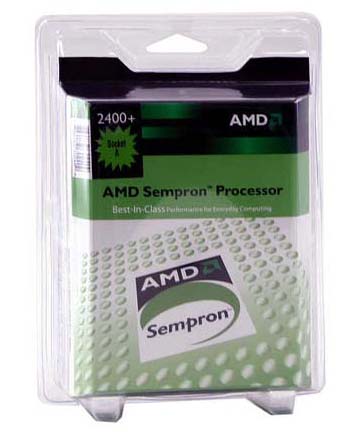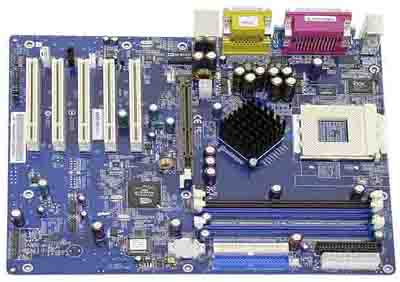Buyer's Guide - Entry Level, October 2004
by Jarred Walton on October 6, 2004 12:05 AM EST- Posted in
- Guides
CPU and Motherboard: Budget Office
For many years, if you wanted to keep up with computing trends you had to be willing to upgrade. This could range from replacing a few parts to purchasing an entirely new system. While that might not be a problem for some, for others it was a difficult proposition. Back in the 80s and 90s, buying a new computer every year or two could cost as much as a used automobile (although reliability might be a concern). Thankfully - depending on whom you ask - things have started to slow down. Many businesses continue to run two or three year old PCs with no real need to upgrade. Any processor running 1 GHz or faster is more than sufficient for surfing the net, writing email, and doing miscellaneous office work. It may not set any speed records, but other than an initial delay while starting up, most office applications spend most of their time waiting on the user.
Office CPU: AMD Sempron 2400+ 256K 1.67 GHz 333 MHz bus
Price: $65 shipped (Retail)
Our recommendation for this month's budget CPU goes to the AMD Sempron 2400+. The Sempron is basically a tweaked version of the venerable Athlon XP Thoroughbred core. Do not let the names confuse you; the Sempron family is meant to compete with the Intel Celeron line of processors and it actually runs at the same speed as the Athlon XP 2000+. However, the Sempron does use a faster 333 MHz bus, which can improve performance slightly, and since the two chips are basically the same price, there is little reason not to opt for the faster bus.
Should you wish to spend a little more on a faster processor, the Athlon XP 2500+ is still a reasonable purchase at roughly $25 more than the Sempron 2400+. It increases clock speed and doubles the amount of cache. However, AMD has recently started to phase out the Athlon XP processors and shift production to the Sempron and Athlon 64 lines, so Athlon XP prices are starting to rise. If you really want to pick up a Barton core Athlon XP, we recommend that you act sooner rather than later - the 2500+ has gone from a low of $75 a few months back to $90.
The Celeron D processor from Intel is also available at relatively low prices, but the price/performance ratio is usually lower than Athlon XP/Sempron. For those who simply have to run an Intel CPU, they are a reasonable alternative. Intel motherboards also tend to cost a little more, so the net result is that $20 will buy a Celeron D 320 and i865PE motherboard which may be slightly faster than the Sempron 2400+. The same $20 would also buy an Athlon XP 2500+, which would be another bump up in speed from the Celeron D 320. We recommend that you stay away from the older Celeron processors, however, as they use a slower bus and have 128K of L2 cache, which really hurts their performance.
Choosing a motherboard in this price segment is extremely difficult. Socket A has been around for over four years now and there have been dozens of chipsets both with and without integrated graphics. If saving money is your top priority, you might want to find an Nforce2 IGP motherboard, as it remains to this day to be one of the best integrated graphics solutions. Prices for these motherboards tend to be around $70 to $80. You will also find numerous refurbished motherboards available at a discount, but we prefer to stick with new models with their longer warranties.

Office Motherboard:Shuttle AN35N-Ultra
Price: $58 shipped
Shuttle gets the nod for our budget motherboard this time, as it includes more high-end features while still providing good reliability and performance. There may be other motherboards that are 1 or 2% faster, but they tend to cost more. The Shuttle features the more advanced Nforce2 Ultra chipset, which provides support for dual-channel memory. Should you be willing to spend a little more money, there are dozens of other motherboards that will work equally well and include additional features like SATA, IEE1394 (Firewire), RAID, and higher quality audio. However, none of those features are necessary and they increase the price slightly.
Update: If you read this guide earlier, you may have seen the Asus A7N8X-X recommended. Some of our readers were good enough to remind us that this board does not support dual-channel RAM. While it might only make a 3 to 5% difference in performance, the Shuttle supports this feature and costs less, and we have no problem wiht recommending it as in place of the ASUS. Abit, Albatron, ASRock, Chaintech, MSI, and quite a few other companies provide good motherboards at very low prices. The only feature that we still insist on for any socket A motherboard is that it use an Nforce2 chipset. Not even the new KT880 is able to fully match the performance of the Nforce2, and since they remain roughly the same price, why settle?










53 Comments
View All Comments
MAME - Wednesday, October 6, 2004 - link
good job jarredJarredWalton - Wednesday, October 6, 2004 - link
Murst,We chose the Sempron 2400+ due to price/performance constraints. It's still $10 cheaper than the cheapest Celeron D, and performance is about the equivalent of the Celeron D 325 (which costs $20 more). Combine that with the fact that a reasonable quality motherboard will also cost a little more, and we end up with recommending the Socket A Sempron over the Celeron D. If you want budget overclocking, the Celeron D wins, but that's a different topic.
You can read our initial comparison of the Celeron D and Sempron chips here: http://www.anandtech.com/cpuchipsets/showdoc.aspx?... We did not actually test the Sempron 2400+, but it's performance should be at worst the same as or slightly faster than the Athlon XP 2000+. We didn't test that either, of course, but if you take the average of the 1700+ and 2200+, you can guesstimate.
And of course, prices for this article were gathered over the past week, so some of them are now off by a few dollars. Oh, well. :)
Murst - Wednesday, October 6, 2004 - link
Why choose the Sempr0n...I thought it was pretty much accepted that similar celeron-ds run faster and actually cost less (cpu+MB) - that does not include the 3100+ but that's not the issue here.
Murst